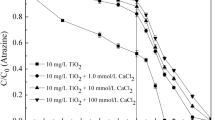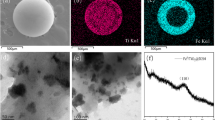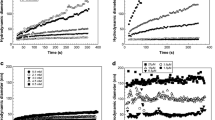Abstract
The colloidal stability and photocatalysis of nano-TiO2 particles were investigated in the presence of fulvic acids (FA) and electrolytes (NaNO3, Na2SO4, Na3PO4) at different pH. Results showed that increasing FA concentration, the absolute value of zeta potential of nano-TiO2 increased and particle size decreased at all pH which promoted the colloidal stability of nano-TiO2. Particle size of nano-TiO2 was larger with the coexistence of FA and electrolytes than with FA only as the concentration of electrolytes was greater than or equal to 0.01 mol/L. The largest particle size occurred in the presence of Na3PO4, followed by Na2SO4 and NaNO3. Particle size of nano-TiO2 decreased with higher pH and stability further increased in the presence of FA and/or electrolytes. Nano-TiO2 stabilization was enhanced by increasing FA concentration when the solution pH was 7.0. However, the removal efficiency of atrazine by nano-TiO2 decreased with the increase in FA concentration. Adding electrolytes (0.01 mol/L), atrazine removal by nano-TiO2 further decreased, albeit slightly. The inhibitory effect of electrolytes on nano-TiO2 removal of atrazine was highest for Na3PO4, followed by Na2SO4, and NaNO3, which were consistent with the results of colloidal stability of nano-TiO2. These findings help to better understand the mechanisms and correlation between colloidal stability and photocatalysis of nano-TiO2 in the presence of FA and electrolytes.








Similar content being viewed by others
References
Asiltürk M, Sayilkan F, Arpac E (2009) Effect of Fe3+ ion doping to TiO2 on the photocatalytic degradation of Malachite Green dye under UV and vis-irradiation. J Photochem Potobiolo A Chem 203:64–71
Borthakur P, Das MR (2018) Hydrothermal assisted decoration of NiS2 and CoS nanoparticles on the reduced graphene oxide nanosheets for sunlight driven photocatalytic degradation of azo dye: effect of background electrolyte and surface charge. J Colloid Interface Sci 516:342–354
Chen M, Qin XS, Zeng GM (2017a) Biodiversity change behind wide applications of nanomaterials? Nano Today 17:11–13
Chen M, Zeng GM, Huang DL, Lai C, Liu Y, Xu P, Zhang C, Wan J, Hu L, Xiong WP, Zhou CY (2017b) Salicylic acid-methanol modified steel converter slag as heterogeneous Fenton-like catalyst for enhanced degradation of alachlor. Chem Eng J 327:686–693
Dionysiou DD, Suidan MT, Bekou E, Baudin I, Laine JM (2000) Effect of ionic strength and hydrogen peroxide on the photocatalytic degradation of 4-chlorobenzoic acid in water. Appl Catal B Environ 26:153–171
Dippon U, Pabst S, Klitzke S (2018) Colloidal stabilization of CeO2 nanomaterials with polyacrylic acid, polyvinyl alcohol or natural organic matter. Sci Total Environ 645:1153–1158
Dong HR, Lo IMC (2013) Influence of humic acid on the colloidal stability of surface-modified nano zero-valent iron. Water Res 47:419–427
French RA, Jacobson AR, Kim B, Isley SL, Penn RL, Baveye PC (2009) Influence of ionic strength, pH, and cation valence on aggregation kinetics of titanium dioxide nanoparticles. Environ Sci Technol 43:1354–1359
He HJ, Cheng Y, Yang CP, Zeng GM, Zhu CY, Yan Z (2017) Influences of anion concentration and valence on dispersion and aggregation of titanium dioxide nanoparticles in aqueous solutions. J Environ Sci 54:135–141
He HJ, Xiang ZH, Chen XJ, Chen H, Huang H, Wen M, Yang CP (2018) Biosorption of Cd(II) from synthetic wastewater using dry biofilms from biotrickling filters. Int J Environ Sci Technol 15:1491–1500
Hsiung CE, Lien HL, Galliano AE, Yeh CS, Shih YH (2016) Effects of water chemistry on the destabilization and sedimentation of commercial TiO2 nanoparticles: role of double-layer compression and charge neutralization. Chemosphere 151:145–151
Lin SC, Shih CJ, Sresht V, Rajan AG, Strano MS, Blankschtein D (2017) Understanding the colloidal dispersion stability of 1D and 2D materials: perspectives from molecular simulations and theoretical modeling. Adv Colloid Interface Sci 244:36–53
Lin Y, Wu SH, Li X, Wu X, Yang CP, Zeng GM, Peng YR, Zhou Q, Lu L (2018a) Microstructure and performance of Z-scheme photocatalyst of silver phosphate modified by MWCNTs and Cr-doped SrTiO3 for malachite green degradation. Appl Catal B: Environ 227:557–570
Lin D, Cai P, Peacock CL, Wu YC, Gao CH, Peng WX, Huang QY, Liang W (2018b) Towards a better understanding of the aggregation mechanisms of iron (hydr) oxide nanoparticles interacting with extracellular polymeric substances: role of pH and electrolyte solution. Sci Total Environ 645:372–379
Loosli F, Le Coustumer P, Stoll S (2013) TiO2 nanoparticles aggregation and disaggregation in presence of alginate and Suwannee River humic acids, pH and concentration effects on nanoparticles stability. Water Res 47:6052–6063
Loosli F, Le Coustumer P, Stoll S (2014) Effect of natural organic matter on the disagglomeration of manufactured TiO2 nanoparticles. Environ Sci Nano 1:154–160
Ma XY, Sun ZR, Hu X (2018) Synthesis of tin and molybdenum co-doped TiO2 nanotube arrays for the photoelectrocatalytic oxidation of phenol in aqueous solution. Mater Sci Semicond Process 85:150–159
Mendoza JA, Lee DH, Kim LH, Kim IH, Kang JH (2018) Photocatalytic performance of TiO2 and WO3/TiO2 nanoparticles coated on urban green infrastructure materials in removing nitrogen oxide. Int J Environ Sci Technol 15:581–592
Parra S, Stanca SE, Guasaquillo I, Thampi KR (2004) Photocatalytic degradation of atrazine using suspended and supported TiO2. Appl Catal B Environ 51:107–116
Pelaez M, de la Cruz AA, O’Shea K, Falaras P, Dionysiou DD (2011) Effects of water parameters on the degradation of microcystin-LR under visible light-activated TiO2 photocatalyst. Water Res 45:3787–3796
Rani M, Shanker U (2018) Degradation of traditional and new emerging pesticides in water by nanomaterials: recent trends and future recommendations. Int J Environ Sci Technol 15:1347–1380
Romanello MB, Cortalezzi MM (2013) An experimental study on the aggregation of TiO2 nanoparticles under environmentally relevant conditions. Water Res 47:3887–3898
Samsudin EM, Hamid SBA, Juan JC, Basirun WJ, Kandjani AE, Bhargava SK (2015) Controlled nitrogen insertion in titanium dioxide for optimal photocatalytic degradation of atrazine. RSC Adv 5:44041–44052
Shvadchina YO, Cherepivskaya MK, Vakulenko VF, Sova AN, Stolyarova IV, Prikhodko RV (2015) The study of properties and catalytic activity of titanium dioxide doped with sulphure. J Water Chem Technol 37:283–288
Tang Z, Cheng T, Fisher-Power LM (2018) Influence of aggregation on nanoscale titanium dioxide (nTiO2) deposition to quartz sand. Chemosphere 209:517–524
Thio BJR, Zhou DX, Keller AA (2011) Influence of natural organic matter on the aggregation and deposition of titanium dioxide nanoparticles. J Hazard Mater 189:556–563
Wang Q, Cissoko N, Zhou M, Xu XH (2011) Effects and mechanism of humic acid on chromium (VI) removal by zero-valent iron (Fe0) nanoparticles. Phys Chem Earth 36:442–446
Wang PF, Qi N, Ao YH, Hou J, Wang C, Qian J (2016) Effect of UV irradiation on the aggregation of TiO2 in an aquatic environment: influence of humic acid and pH. Environ Pollut 212:178–187
Wang H, Wu Y, Feng MB, Tu WG, Xiao T, Xiong T, Ang HX, Yuan XZ, Chew JW (2018) Visible-light-driven removal of tetracycline antibiotics and reclamation of hydrogen energy from natural water matrices and wastewater by polymeric carbon nitride foam. Water Res 144:215–225
Wu JH, Liu W, Xue CB, Zhou SC, Lan FL, Bi L, Xu HB, Yang XL, Zeng FD (2009) Toxicity and penetration of TiO2 nanoparticles in hairless mice and porcine skin after subchronic dermal exposure. Toxicol Lett 191:1–8
Wu Y, Wang H, Tu WG, Liu Y, Wu SY, Tan YZ, Chew JW (2018a) Construction of hierarchical 2D-2D Zn3In2S6/fluorinated polymeric carbon nitride nanosheets photocatalyst for boosting photocatalytic degradation and hydrogen production performance. Appl Catal B Environ 233:58–69
Wu Y, Wang H, Sun YM, Xiao T, Tu WG, Yuan XZ, Zeng GM, Li SZ, Chew JW (2018b) Photogenerated charge transfer via interfacial internal electric field for significantly improved photocatalysis in direct Z-scheme oxygen-doped carbon nitrogen/CoAl-layered double hydroxide heterojunction. Appl Catal B Environ 227:530–540
Wu Y, Wang H, Tu WG, Wu SY, Liu Y, Tan YZ, Luo HJ, Yuan XZ, Chew JW (2018c) Petal-like CdS nanostructures coated with exfoliated sulfur-doped carbon nitride via chemically activated chain termination for enhanced visible-light–driven photocatalytic water purification and H2 generation. Appl Catal B Environ 229:181–191
Wu SH, Li HR, Li X, He HJ, Yang CP (2018d) Performances and mechanisms of efficient degradation of atrazine using peroxymonosulfate and ferrate as oxidants. Chem Eng J 353:533–541
Wu SH, He HJ, Li X, Yang CP, Zeng GM, Wu B, He SY, Lu L (2018e) Insights into atrazine degradation by persulfate activation using composite of nanoscale zero-valent iron and graphene: Performances and mechanisms. Chem Eng J 341:126–136
Yang SP, Bar-llan O, Peterson RE, Heideman W, Hamers R, Pedersen JA (2013) Influence of humic acid on titanium dioxide nanoparticle toxicity to developing zebrafish. Environ Sci Technol 47:4718–4725
Yu JP, He HJ, Yang WL, Yang CP, Zeng GM, Wu X (2018) Magnetic bionanoparticles of Penicillium sp. yz11-22N2 doped with Fe3O4 and encapsulated within PVA-SA gel beads for atrazine removal. Bioresour Technol 260:196–203
Yuan RF, Liu D, Wang SN, Zhou BH, Ma FS (2018) Enhanced photocatalytic oxidation of humic acids using Fe3+–Zn2+ co-doped TiO2: the effects of ions in aqueous solutions. Environ Eng Res 23:181–188
Zhu XS, Zhou J, Cai ZH (2011) TiO2 nanoparticles in the marine environment: impact on the toxicity of tributyltin to abalone (Haliotis diversicolor supertexta) embryos. Environ Sci Technol 45:3753–3758
Zhu CY, Yang WL, He HJ, Yang CP, Yu JP, Wu X, Zeng GM, Tarre S, Green M (2018) Preparation, performance and mechanisms of magnetic Saccharomyces cerevisiae bionanocomposites for atrazine removal. Chemosphere 200:380–387
Acknowledgements
The authors gratefully acknowledge the financial support by the International S&T Cooperation Program of China (Project Contract No. 2015DFG92750), the National Natural Science Foundation of China (Grant Nos. 51478172, 51508538, 51278464 and 51521006), the Natural Science Foundation of Zhejiang Province of China (Grant Nos. LY17E080002) and the Department of Science and Technology of Hunan Province of China (Contract Nos. 2017JJ2029 and 2017SK2362). They also thank Dr. Zhiqiang Shen for his valuable comments during the preparation and revising procedure of the manuscript.
Author information
Authors and Affiliations
Corresponding author
Ethics declarations
Conflict of interest
There are no conflicts to declare.
Additional information
Editorial responsibility: M. Abbaspour.
Rights and permissions
About this article
Cite this article
He, H., Wu, B. & Yang, C. Effects of fulvic acids and electrolytes on colloidal stability and photocatalysis of nano-TiO2 for atrazine removal. Int. J. Environ. Sci. Technol. 16, 7275–7284 (2019). https://doi.org/10.1007/s13762-018-2148-2
Received:
Revised:
Accepted:
Published:
Issue Date:
DOI: https://doi.org/10.1007/s13762-018-2148-2




